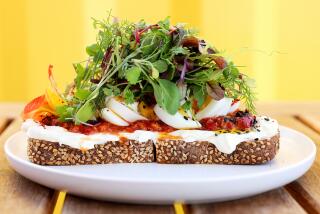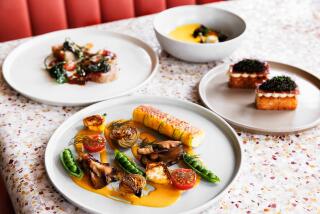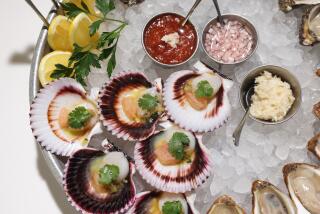Hooked on Istanbul Seafood : Where Europe and Asia meet, fish provides the tie that binds
- Share via
ISTANBUL, Turkey — My host craved fish, and nothing else would do. A Turk who works and lives in America, he was home on vacation, and his mouth was watering for one of Turkey’s great treats. Though we were in Europe, he suggested we go to Asia for dinner. But this was simple in Istanbul, a city that straddles both continents, with the Bosporus Strait the easily crossed divider between the two.
We set out in a motor launch that had been sent by the restaurant to transport us to the Asian side of the city, to Anatolia, the part of Turkey that’s in Asia.
As we sped across the dark Bosporus, I could see the illuminated palaces of Turkey’s Ottoman past growing smaller and smaller on the European shore, their white reflections cut to ribbons by the choppy waves.
At Seaport, as the restaurant is called, the owner greeted us warmly and led us to a display of fish on an awninged cart in the garden. The silvery specimens--I counted half a dozen kinds--glittered on a bed of chipped ice. Under the glare of the cart’s naked lightbulbs, no cloudy eye stared back at me as I inspected the lineup, nor did any sour odor rise to assault my nose. This fish was fresh. Indeed, in Istanbul, it is seldom otherwise.
With water surrounding three-fourths of the country, fish from the Black Sea to the north and the Aegean and Mediterranean to the south (to say nothing of the local Sea of Marmara and the Bosporus) arrives daily at Istanbul’s markets, just hours after being caught. And it is only hours later that the catch appears in the city’s fish restaurants, some specimens still alive, kept in glass tanks or pools, as at the giant Urcan restaurant, where customers can choose the exact ones they want for dinner. Depending on the season, restaurants offer everything from swordfish and bluefish to red mullet, turbot, sardines and anchovies. And for shellfish lovers, there are mussels, langoustines and jumbo shrimp.
Istanbul’s seafood restaurants tend to be simple, homey places. Indeed, some are holes in the wall, serving such favorites as charcoal-grilled fish and deep-fried mussels. Others are upscale and refined, such as Korfez, which also lies on the Asian side and tempts with sole souffle and sea bass wrapped in lettuce leaves.
Location is often part of its draw. Most restaurants are on or near the Bosporus and the adjacent Sea of Marmara, and many offer spectacular views of the water and the city’s minaret-punctuated skyline.
In this piscatorial paradise, it surprised me to learn that the Turks abjured fish when they swept into Anatolia on horseback in the 11th century and settled down. Not until the 1960s, when the boom in foreign tourism got started, did seafood grow truly popular. Away from Istanbul and the other large cities, I am told, there are Turks today who still turn up their noses at fish and consider shellfish an abomination.
At Seaport, once a rich man’s mansion with spacious rooms and flower-painted ceilings, I was introduced to the ritual of a Turkish fish dinner. First came the mezes, or appetizers, to be nibbled with anise-flavored raki, the clear and powerful Turkish liquor that turns instantly milky mixed with water. (Not for nothing do the Turks call it lion’s milk.)
The mezes arrived one after another on small oval plates: grape leaves stuffed with rice, currants and pine nuts; tart yogurt with dill, garlic and cucumber; a puree of charcoal-roasted eggplant, lemon juice and olive oil, with a subtle smoky taste; pressed, salt-cured palmut, or bonito, a type of small tuna; marinated octopus; mussels with rice pilaf; and--as a sign of Turkey’s growing internationalism--Iranian caviar and Scandinavian gravlax. These were followed by a plate of piping hot borek, triangular pockets of flaky pastry filled with ground meat and sharp cheese. As my host had explained when the parade of mezes began, the point is to enjoy, not overindulge. Fine words, but not easy to follow, as I discovered.
The second course consisted of baked sea bass encased in salt. The hardened coat cracked open at the first blow of our waiter’s hammer to reveal the steaming fish inside. Deftly stripping away the skin with two forks, he lifted portions of the delicate flesh onto our plates. The juices of the bass had mingled with those of the mushrooms and shrimp that filled the body cavity. The bass was moist and sweet, without a trace of the salt. And, as should be the case when fish is as fresh as this one, the accompaniments were modest: a salad of arugula, sliced onion and tomato with an olive oil and lemon juice dressing and a chilled bottle of Turkish dry white wine.
*
My education in Turkish seafood was to continue the next day when I got in touch with the English-speaking head chef of the five-star Regency Hyatt Hotel. A Swiss citizen with an Italian name and a French accent, Silvio Bianchi had, on a friend’s recommendation, agreed to take me to a market so that I could see for myself the variety of fish and other produce available. He led me through an Aladdin’s cave of gustatory treasures called the Balik Pazari: two covered streets in the Galatasaray district, lined on both sides with stalls and shops.
“Food is not fancy here,” Bianchi told me. “Vegetables are allowed to taste of themselves. That’s why mezes are so delicious. Why fuss when a tomato has all the flavor of the sun?”
It was, of course, fish that I had come to see. Forming stunning still lifes, they lay fanned out on round red-lacquer trays or lined up like bars of silver. Some rested on their bellies, their bodies gently curved to make them look as though they were alive, swimming upstream. The gills of sleek bonito--deliberately extruded to show how recently the fish had left water--formed blood-red ruffs around their heads.
I found fish wherever I went in Istanbul. Walking across the Galata Bridge over the Golden Horn, I caught sight of dozens of men of all ages leaning against the railing, intently fishing. The churning of the water caused by the incessant traffic of commuter ferries and other vessels apparently stirs up the nutrients that attract the fish to the area.
Before the new bridge was built, fish restaurants lined the pier of the old pontoon span it replaced: a structure--and a convention--still much missed. Surviving from the past are two barge-like boats on either side, moored to the broad landing area. Aboard these floating kitchens fish fillets are grilled over charcoal, slapped between half loaves of bread and handed out through the smoke to customers on the quay who line up for the treat.
Just opposite the boats stands the building housing the bustling and aromatic Spice or Egyptian Bazaar (Misir Carsisi). Its stalls contain shops selling all the flavors of the Near East: greenish cumin, ground red pepper, yellow turmeric and saffron piled in bags and boxes and heaped into miniature volcanoes, with strings of dried okra, peppers and eggplant dangling overhead. But I had little time to linger, having made a reservation for lunch upstairs at an Istanbul institution, the blue-and-aqua-tiled Pandeli restaurant.
Open only for lunch, Pandeli should nevertheless be on everyone’s list of must-go eating places on a visit to Turkey, if only for the sea bass, a house specialty baked in a parchment paper case. Nothing could be simpler: Lumps of salted butter and wedges of fresh tomato placed on top of the fish melt into its juices to form a light sauce that can be sopped up with the excellent Turkish bread.
*
The fish lunch settled so well I decided to have another the next day when I took a cruise up the Bosporus by ferry. Along with a stream of other hungry passengers, I got off at the last stop, a fishing village called Andalou Kavagi, which lies but a few miles from the Black Sea. Though I knew it was famous for its fish restaurants, I was unprepared for their number. I found them standing cheek by fin all around the harbor: bright, clean establishments, with the local catch displayed temptingly outside each on beds of ice. I settled for a place right on the water called Yosun and was not to be disappointed by the mezes, the grilled bluefish I ordered or the view.
Plainly, Turks know how to cook fish. They also know how to charge for it, and the traveler must be wary. I was the innocent when I took another ferry a couple of days later to the Princes’ Islands in the Sea of Marmara, summer resorts from which all motorized traffic has been banned. I paused for lunch at the largest of these, Buyukda. Once again fish restaurants dominated others. I picked one with an awning, Birtat, with tables overlooking the sea and ordered lagos, a special fish, I was informed. That should have been warning enough. My mistake was not to have selected it from the refrigerated case and not to have had the waiter weigh it first, a custom Turks follow so that price can be established in advance. As a result, I was charged a hefty sum for two large fillets when one would have suited me fine.
*
Among Istanbul’s greatest delights is Kumkapi, a neighborhood on the Sea of Marmara, given over entirely to the enjoyment of seafood. There are about 50 restaurants within its boundaries, jammed side by side, with tables that spill out onto the pavement and crowd up against each other.
Without a recommendation to go by, I found choosing a restaurant anxiety provoking, and all the more so because each seemed to keep a tout outside. I finally threw up my hands and took a sidewalk table at a cozy-looking place called Capari, which, though the hour was still early for dining, already had attracted quite a few Turkish customers. I chose well. I was pleased not only by the mezes and the main course (skewered chunks of grilled swordfish marinated in olive oil and lemon juice, each chunk separated by a lemon slice and a bay leaf), but by the free entertainment supplied by an endless flow of passersby.
From my front-row seat, I watched a parade of ambling foreigners and locals: young boys selling flowers, a man hawking a ship model he had made and groups of troubadours wandering from restaurant to restaurant, playing music and singing songs, all in noisy competition with one another. The fluorescent brightness, the ever-rising decibel level, the general merriment of Kumkapi charmed me. I sat alone, but I did not feel alone. And when I got up to return to my hotel, I felt as though I were leaving a very good party. Under the relaxing effect of the raki they had drunk, six men had shoved back their chairs at a long table, risen together, linked arms and in an expression of Turkish joy, began dancing in the street as I walked from the light into the darkness.
(BEGIN TEXT OF INFOBOX / INFOGRAPHIC)
GUIDEBOOK
Piscatorial Istanbul
Where to eat: A seafood dinner for one person, including beer or wine, will cost from $7 to $25. Ask your hotel clerk to arrange taxi transportation to any of the recommended restaurants below:
Ali Baba, Kirecburnu Caddesi 20, Kirecburnu district.
Capari, in the Kumkapi district.
Fayco, Kirecburnu Caddesi 13, Tarabaya District.
Hasan Baliksilar, Yat Limani, Rihtim Sokak 8, Yesilkoy district (near the airport).
Huzur (Arabin Yeri), Salacak Iskelesizo Caddesi 20, Uskudar district. Asian side of city.
Inci Restaurant & Cafe, Salacak Sahil Yolu, Uskudar district. Asian side.
Korfez, Korfez Caddesi 78, Kanlica district. Asian side, north of the Bosporus Bridge; reservations recommended, local telephone (216) 413-4314.
Kor Agop, Kumkapi district.
Olimpiyat 2, Kumkapi district.
Paysage, Hekimler Sitesi, Kanlica district. Asian side.
Pandeli, Misir Carsi 1; lunch only. Above the Spice or Egyptian Bazaar (Misir Carsisi), Eminonu district.
Seaport, Yaliboyu Caddesi 36, Beylerbeyi district. Asian side; reservations recommended, tel. (216) 321-1494.
Urcan restaurant, Sariyer district.
For more information: Turkish Tourist Office, 821 United Nations Plaza, New York, NY 10017; tel. (212) 687-2194, fax (212) 599-7568.
--D.M.B.
More to Read
Sign up for The Wild
We’ll help you find the best places to hike, bike and run, as well as the perfect silent spots for meditation and yoga.
You may occasionally receive promotional content from the Los Angeles Times.






